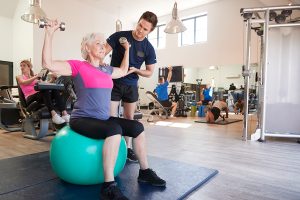 Yes, I know we’re still dealing with a life-changing pandemic around the world and especially in most areas of the United States, but it is still worth thinking ahead to what comes next. Despite a current focus on non-gym fitness trends (see an article in Time [1]), it is more than likely that many of us have experienced a change (most often a decrease) in our daily physical activities and, subsequently, in our aerobic and muscular fitness levels.
Yes, I know we’re still dealing with a life-changing pandemic around the world and especially in most areas of the United States, but it is still worth thinking ahead to what comes next. Despite a current focus on non-gym fitness trends (see an article in Time [1]), it is more than likely that many of us have experienced a change (most often a decrease) in our daily physical activities and, subsequently, in our aerobic and muscular fitness levels.
A 2020 study conducted in Washington state (the state first impacted by curtailed daily activities) showed that strategies to mitigate the COVID-19 pandemic has impacted people’s physical activity and mental health, with those experiencing a decrease in physical activity also having higher levels of stress and anxiety (2). While a few of us may have gotten more active while working from home or having an altered daily life, the rest of us have had to curtail our activities—if not our workouts in public spaces like gyms and pools, at least our daily movement. When confined to our homes for working and learning, the lack of a daily commute to arrive at work or school by itself can remove a lot of daily steps that people would otherwise be taking, and mental stress and anxiety may be leading people to engage in other less healthy behaviors like stress eating.
 Past research has demonstrated greater strength gains and blood glucose improvements in people with type 2 diabetes from doing resistance training using harder weights or resistance than most people have access to at home, and regular participation is reinforced by supervision during training sessions and/or by social support arising from group exercise (2,3) What does that say about the future of working out at home, seldom if ever supervised and often alone? It may be hard to predict, but it is undeniable that doing any activity is better than none at all. Nonetheless, it is entirely likely that we will have lost some aerobic capability and muscular strength by the time we are able to restart our pre-pandemic activities.
Past research has demonstrated greater strength gains and blood glucose improvements in people with type 2 diabetes from doing resistance training using harder weights or resistance than most people have access to at home, and regular participation is reinforced by supervision during training sessions and/or by social support arising from group exercise (2,3) What does that say about the future of working out at home, seldom if ever supervised and often alone? It may be hard to predict, but it is undeniable that doing any activity is better than none at all. Nonetheless, it is entirely likely that we will have lost some aerobic capability and muscular strength by the time we are able to restart our pre-pandemic activities.
So, what can we do to prepare to fully reenter the fitness world after it is finally considered safe to resume our pre-pandemic lifestyles? The best way to be ready is to stay as active as possible by doing anything you can from home or other safe venues now. That includes getting involved in virtual fitness classes, dusting off and using any exercise equipment you have at home, doing exercises using your body weight as resistance, and breaking up your sedentary time frequently, regardless of where you are working or learning.
Here are some other tips to keep in mind:
- Find some time every day to be active, even if you only stand up during meetings instead of sitting or do easy exercises next to your desk.
- Do more spontaneous activity, including getting up to break up sitting time for a few minutes every 20 to 30 minutes.
- Use whatever equipment or household items you have access to in order to add a little resistance training to your day (aim for two to three days per week).
- Use the latest technology or other tracking device to make sure you are getting in a minimum of activity every day (set daily and weekly goals for yourself).
- Start out slowly and progress slowly over time once you can get back into doing more and harder activities as your top priority should be gaining fitness without injuring yourself.
Remember, when you’re starting out all over again, the same principles apply as when you began getting physically fit in the first place. Avoid the pitfalls that can lead to injury and demotivation, such as starting back at too high of an intensity. Hopefully, if nothing else, this pandemic will have lead people to become more creative with their workouts and help everyone find ways to fit in more activity into their daily lives, during and after we’re through this rough patch.
References:
- Time magazine, July 15, 2020: https://time.com/5867166/covid-19-gyms-exercise/?fbclid=IwAR1DVNQEd03PaHdwZXSKlRNhYvlMosxVYg_Gfy5weAyk89Q5NTt82DRY8og
- Duncan GE, Avery AR, Seto E, Tsang S. Perceived change in physical activity levels and mental health during COVID-19: Findings among adult twin pairs. PLoS One. 2020;15(8):e0237695. Published 2020 Aug 13. doi:10.1371/journal.pone.0237695
- Dunstan DW, Daly RM, Owen N, et al. High-intensity resistance training improves glycemic control in older patients with type 2 diabetes. Diabetes Care. 2002;25(10):1729-1736. doi:10.2337/diacare.25.10.1729
- Dunstan DW, Daly RM, Owen N, et al. Home-based resistance training is not sufficient to maintain improved glycemic control following supervised training in older individuals with type 2 diabetes. Diabetes Care. 2005;28(1):3-9. doi:10.2337/diacare.28.1.3
- Dempsey PC, Larsen RN, Sethi P, et al. Benefits for Type 2 Diabetes of Interrupting Prolonged Sitting With Brief Bouts of Light Walking or Simple Resistance Activities. Diabetes Care. 2016;39(6):964-972. doi:10.2337/dc15-2336
Sheri R. Colberg, PhD, is the author of The Athlete’s Guide to Diabetes: Expert Advice for 165 Sports and Activities (the newest edition of Diabetic Athlete’s Handbook). She is also the author of Diabetes & Keeping Fit for Dummies, co-published by Wiley and the ADA. A professor emerita of exercise science from Old Dominion University and an internationally recognized diabetes motion expert, she is the author of 12 books, 30 book chapters, and over 420 articles. She was honored with the 2016 American Diabetes Association Outstanding Educator in Diabetes Award. Contact her via her websites (SheriColberg.com and DiabetesMotion.com).
